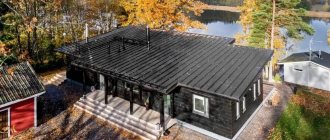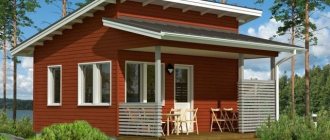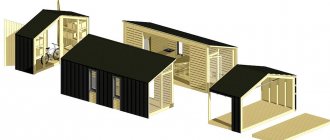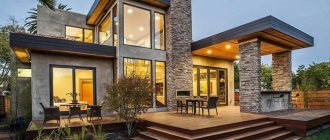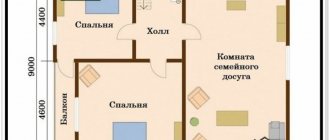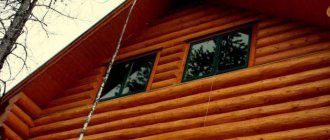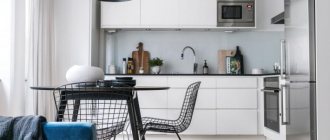You can download frame house design programs quite easily on the Internet, but before loading such a program into the operating memory of your computer, read a short review about their capabilities in order to ultimately choose a program that is suitable for designing your frame house.
Content:
- Important Design Points
- Undesirable factors when designing a house
- Drafting
- Project creation stages
- Top 10 programs for self-design
- Google SketchUp
- Revit
- AutoCad
- SweetHome
- FloorPlan 3D
- ArchiCAD
- Arcon
- Autodesk 3ds Max
- KZ - cottage
- Chief Architect
- Conclusion
- Video on the topic of designing wooden houses
Before any construction begins, there is a design stage. Before the widespread use of computers, and with them special programs, projects were made by hand: with pencil and ink on paper. But now either sketches are made on paper, or the initial stage of engineering graphics is going through at universities.
Porch and terrace
The terrace or its small variations is a wing, which has both a functional load and a stylish appearance. A terrace is an open area with one wall, a kind of extension on supports or pillars. From above, the porch is covered with a roof of the same type as the house or can be erected separately. The terrace is especially popular in the southern regions of the country, since it is often warm there and this area is used regularly. Here you can have a good time with friends or relatives, sit at the dining table in the fresh air, whether the weather is sunny or cloudy. Now the terrace is gaining more and more popularity, it can be used both on one side of the house and along its entire perimeter. Thus, it not only changes the appearance of a wooden house, but also improves it.
Houses with a veranda are especially popular in cooler regions, where additional walls are erected and the area is arranged with the possibility of using heating systems. There is no need to confuse a terrace and a veranda, since the terrace is open and suitable only for summer, but the veranda is an enclosed space with walls and windows. Its purpose is also different, since first of all it is a room to protect the entrance to the house from the vagaries of the weather.
Important Design Points
Design begins with a sketch of the project itself. Moreover, sketches can be both rough and fine. The difference between a sketch and a drawing is that the first has no reference to dimensions, axes, etc., in fact, a sketch is an ordinary drawing. The drawing is carried out according to SNIPs and GOSTs, displaying both axes and dimensions. Drawings must cover all aspects of future construction and design of the building. For landscaping, there are also drawings that are submitted to the appropriate authorities.
Undesirable factors when designing a house
Since wood has its own negative factors, this is where some design limitations arise. It is necessary to take into account the Wind Rose in the area, the groundwater level, and the depth of soil freezing. Also, if the project is located near rivers and reservoirs, the fact how much the water level rises during spring floods is also taken into account. But not only natural factors influence - do not forget about the quality and type of wood, as well as the processing of the material itself before starting construction work. This should also be indicated in the project.
Drafting
After agreeing on the sketch with the customer and approval, the actual design begins. Before starting, all the necessary data on climatic conditions are collected, permits are collected from the relevant authorities (sometimes this is done at the end), the material is selected and the approximate construction time is informed to the customer.
Project creation stages
According to GOST, there are 5 main stages of project creation. Of course, in reality they are not done in a set order, but simultaneously. But it looks, according to GOST, as follows:
- Technical task. This includes the development of the project from the point of view of its profitability, work on studying the future construction site, materials, justification of input data, and at the end the terms of reference are approved.
- Preliminary design. Everything is simple here - a sketch is created, as mentioned above, and approved.
- Technical project. At this stage, there is a detailed calculation and calculation of all possible values of the future project. Also, the future progress of work, completion dates and delivery dates are calculated. The technology and organization of the work performed are calculated, and a preliminary estimate is drawn up. After this, the project must be approved and it moves to the next stage.
- Working draft. Essentially, this is the same technical project in which edits are made on site. Work is carried out on this project and adjusted (if necessary). During construction, you need to strictly follow the project, coordinating changes with the design bureau or organization, since even the most minor structural change can lead to a partial or complete loss of the structure’s technological properties. During construction, the State Architectural and Construction Supervision constantly monitors the progress of work. In addition to the customer, GASN must accept the object; without the signature of this organization, operation will be prohibited.
- Implementation. In other words – delivery of the project. The completed and agreed upon project is transferred to the customer to complete the work.
Tasks and capabilities of software
Manual design of houses on paper is a thing of the past. The program for creating a frame house project helps to save time and effort, and anyone can create their own projects.
Such utilities allow you not only to create a drawing, they clearly display all the information the user needs about the house, show every detail of the project, allow you to see a three-dimensional model of the future structure and even experiment with the design and arrangement of furniture.
The main advantage of such software is that most of the work happens automatically. You can create your own project even without any special knowledge of it. Moreover, most of the utilities are easy to use.
Today you can find many similar programs on the Internet, but the most feature-rich ones are usually paid or have a limited number of free functions. Free software is also available, and some of them do not even have the same functionality as paid software.
Important! Many additional functions will not always come in handy. For example, frame construction is quite simple, and a good free program will be enough to design it.
Paid applications with huge functionality are more suitable for professionals.
Advantages of working with the program:
- Even if there are some errors in the drawing, they can be easily corrected at any stage of the work. You don't have to redo everything all over again;
- The program is also suitable for calculating a frame house. As the project is created, it allows you to determine the required quantity of all materials and resources. All this happens automatically;
- Using such utilities greatly simplifies the creation of house drawings. All the necessary tools and tips will be right on the screen. If you get the hang of using the application, the process will take a minimum of time.
Such software is quite easy to learn, and the Russian-language menu greatly simplifies the work. The end result is a detailed and understandable drawing of the future structure.
Top 10 programs for self-design
Of course, now special programs are used to create projects, at least their drawing part. They come in different varieties, from the simplest ones, where you can create a sketch, to advanced options for real professionals. Here are the main design programs and utilities:
Google SketchUp.
The program is designed for an inexperienced user who knows about design only by hearsay. Of course, you will need some knowledge, but there are enough tips there. The program is used for designing 3D models, sketches, general plans and general plans. Rather, it refers to design utilities, since the drawings there are very mediocre, not according to GOST. Such a program is quite suitable for those who know what they want from a design organization, but cannot explain - only show. In this program it will be very easy to do this, and with good PC skills, it will also be quick. The program can be both paid and free.
Revit.
This program is intended primarily for professional designers. At least that's what its developers say. It is a budget copy of AutoCad, but its advantages include the possibility of arranging furniture indoors (special blocks). The program is quite new and not very popular due to its relative crudeness. Their bold decisions - the opportunity to work collectively on a project. But there is no official localization, so knowledge of English is required to master it. The program is shareware: it provides a trial period (30 days), after which it requires activation. This will be enough time to master it. Also, during this period you can understand whether it is worth the money requested or whether it is better to switch your attention to other analogues.
AutoCad.
Perhaps one of the most famous and popular programs for both professionals and amateurs. There is no unnecessary information in this product, the training is very primitive. But the interface is intuitive and does not require a separate manual for each block. Starting from version 2011, it is possible to simultaneously design both an object in 2D and 3D. This is very convenient for those who are designing an entire building. The only thing that can cause difficulties is the bottom status bar with unclear symbols. Once you get used to them, you simply won’t be able to draw without using these functions. And since the 2012 version, each function is written in Russian, so it won’t be difficult to understand. Regarding the price, the product is quite expensive, but support for older versions remains after the purchase and release of a new one.
SweetHome.
A program that you won’t be able to master properly without special training and watching videos about working in it. Of course, it is quite simple and understandable, but its structure is made in an extremely illogical way, which is not typical for products in this segment: design and construction are areas of activity where there is a completely direct and rigid logic. One of the advantages of the program can be emphasized that it is quite suitable for designing the interior space of a room, that is, arranging furniture and equipment. To do this, just save the drawing from another program in a format in which SweetHome can read and arrange the furniture. In general, it is quite suitable for interior planning.
FloorPlan 3D.
An excellent program for drawing up preliminary designs, as well as for planning both external and internal. He also copes well with the task of creating territory improvement projects. Another advantage is that during design, certain materials are selected (for example, brick) and with continued use, the program remembers this. Of course, you shouldn’t expect drawings from her, but she copes with her planned tasks quite well.
ArchiCAD.
The product is very similar to AutoCAD. But only this program is more adapted for design. Unlike its “little brother”, it has visualization, in addition to drawings. One of the main features of the program is that at the end of the project, you can display almost all the necessary documents for this task, which will indicate both the materials and the dimensions of the project. Landscaping of the territory, including the surrounding area, is carried out perfectly by the product. Among the negative factors, it is worth noting the difficulty in mastering, since it is a product for professionals, as well as the very high cost. Just like other products of this company, there is a free trial period.
Arcon.
Another program for interior space planning. Unlike its analogues, the approach to design here is quite professional, but intuitive. Allows you to import blocks (for example, furniture) from other programs. Allows you to design the layout of not only residential premises, but also office and industrial facilities. There is no free or trial version, but there are 2 paid versions: with unlimited and limited functionality.
Autodesk 3ds Max.
Professional 3D modeling program. One of my favorite design programs. It creates not only sketches of construction projects, but also other models, including animations with pictures. Models of cars or some household appliances and machines are also made in the same program. The interface is complex; training in using this program is required. The price of this program is very high, and it also requires certain powerful technical characteristics of the computer.
KZ - cottage.
A specially created program for designing houses made of wood and timber. Therefore, it has a very extensive, but narrowly focused functionality, which is fully implemented. Just like in ArchiCAD, there is documentation for the project, including material consumption. The disadvantages include problems with the program itself (problems with saves).
Chief Architect.
Program for designing frame houses. Just like the previous one, it is highly specialized, therefore it has very extensive functionality in its field. The program allows you to make project drawings. Unfortunately, the Russian language is not there, although the developers promise to add it.
Use projects at your discretion
The information in this section can be used in any way at your discretion, however, if you use it for commercial purposes, a mandatory link to the site razbrevnovka.ru!
Here are ready-made house projects with logs made in the LogHouse program. The plans and elevation drawings on the first page of each documentation package are made in AutoCad. Projects from log manufacturers are accompanied by photographs of finished structures or detailed three-dimensional models.
| Facades or photographs | Code | Type of building | Material type | Volume of material |
| RD53 | House | Log 230 mm | 23,510 cubic meters | |
| RD46 | House | Log 210 mm | 51,235 cubic meters | |
| RD32 | House | Log 170 mm | 15,555 cubic meters | |
| RD31 | House | Log 170 mm | 18,076 cubic meters | |
| RD30 | House | Log 170 mm | 20,628 cubic meters | |
| RD127 | House | Beam 134×190 | 21,080 cubic meters | |
| RD67 | House | Log 230 mm | 49,027 cubic meters | |
| RD116 | Bath | Log 170 mm | 22,263 cubic meters | |
| RD101 | House | Beam 180x190 | 93,198 cubic meters | |
| I15 | Bath | Beam 70x145 | 6,384 cubic meters | |
| RSV12 | House | Beam 190x190 | ||
| RSV11 | House | Beam 190x190 | ||
| RSV10 | Bath | Beam 190x134 | 14.9 cubic meters | |
| RD38 | Bath | Log 170 mm | 16,015 cubic meters | |
| RD113 | House | Log 170 mm | 18.34 cubic meters | |
| RD39 | Bath | Log 170 mm | 12.7 cubic meters | |
| RD63 | Bath | Log 170 mm | 11.2 cubic meters | |
| RSV09 | House | Beam 190x190 | 34,641 cubic meters | |
| RSV08 | Bath | Log 200 mm | 21,239 cubic meters | |
| RSV07 | Bath | Beam 145x134 | 13,526 cubic meters | |
| RSV06 | House | Beam 165x220 | 28,501 cubic meters | |
| RSV05 | House | Beam 190×180 | 47,485 cubic meters | |
| RSV04 | Bath | Beam 165x134 | 13.1 cubic meters | |
| RSV03 | House | Beam 190×180 | 63.85 cubic meters | |
| RSV02 | House | Beam 190×180 | 27.1 cubic meters | |
| RSV01 | House | Beam 190×180 | 41.5 cubic meters |
If you are looking for where to order the production of a log house or the construction of a house from logs or timber, we will help you find a contractor: Order a log house >>
If you need to clear logs for a project, we can do it for you: Order log clearing >>
Or you can purchase software to do the logging yourself. You can buy a license for the software package or rent it on a monthly basis: Learn more about LogHouse software >>
